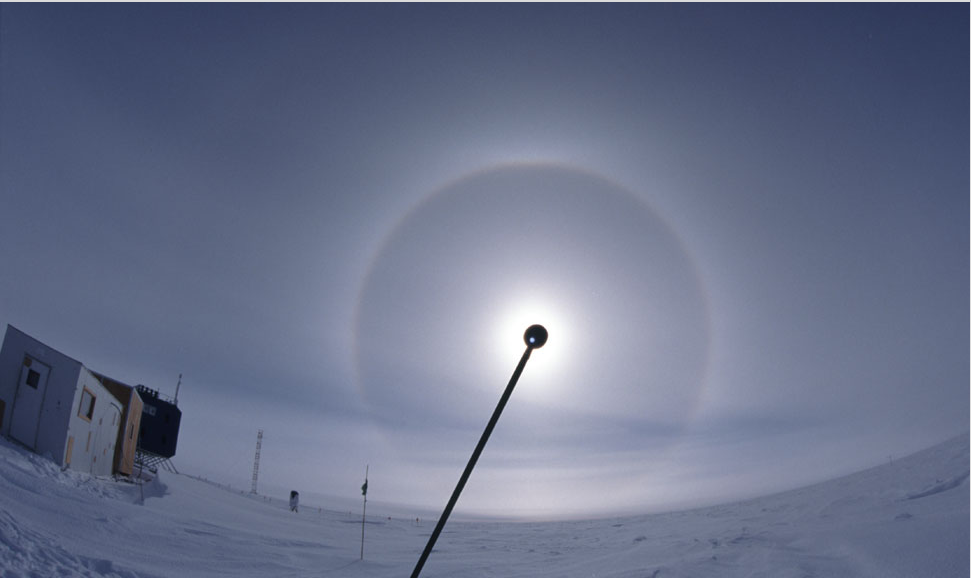22º halo South Pole
Exploring the Phenomenon of the 22º Halo at the South Pole
At the South Pole, amidst the captivating displays of diamond dust halos, a unique atmospheric phenomenon known as the 22-degree halo occasionally graces the skies. Unlike its diamond dust counterparts, this halo is formed within cirrus clouds, creating a stunning spectacle for observers. This article will delve into the intricacies of the 22º halo at the South Pole, shedding light on its formation, appearance, and the tools employed to study its characteristics.
The 22-degree halo is a type of optical phenomenon that manifests as a circular ring encircling the sun or moon. As its name suggests, the halo forms at an angle of approximately 22 degrees from the celestial body it surrounds. While these halos can occur in various locations around the world, their occurrence at the South Pole is particularly captivating due to the unique atmospheric conditions present in this remote region.
To witness this mesmerizing sight, photographers and researchers at the South Pole employ specialized equipment, such as a sun shield equipped with crossed polarizing filters. This ingenious setup allows just enough sunlight to pass through, enabling precise measurements of the halo's size and characteristics. By carefully analyzing these measurements, scientists can gain valuable insights into the physical properties of the halo and its formation process.
The formation of a 22-degree halo involves the interaction of light with ice crystals present in cirrus clouds. These clouds, composed of thin and wispy ice crystals, act as a canvas upon which the halo is painted. When sunlight passes through these hexagonal ice crystals, it undergoes refraction and reflection, resulting in the creation of the halo. The specific angle of 22 degrees arises due to the geometry of the ice crystals and their orientation relative to the observer.
One intriguing aspect of the 22-degree halo at the South Pole is its appearance amidst cirrus clouds rather than diamond dust. Cirrus clouds are high-altitude clouds composed of ice crystals that form under specific atmospheric conditions. The presence of these clouds at the South Pole contributes to the formation of the halo, creating a visually striking display against the polar backdrop.
The 22-degree halo is not limited to the South Pole; it can be observed in various regions across the globe. However, its occurrence in this remote and frigid location adds an extra layer of fascination. The South Pole's extreme climate and pristine air quality provide an ideal environment for studying atmospheric optics phenomena, making it a haven for researchers and photographers alike.
Photographers at the South Pole often capture stunning images of the 22-degree halo, showcasing its ethereal beauty against the icy landscape. These images not only serve as a testament to the remarkable natural phenomena occurring at the Earth's southernmost point but also contribute to our understanding of atmospheric optics and the intricate interplay between light and ice crystals.
In conclusion, the 22-degree halo at the South Pole is a captivating optical phenomenon that occurs within cirrus clouds. Its formation involves the refraction and reflection of sunlight by hexagonal ice crystals present in these clouds. While this halo can be observed in various locations worldwide, its appearance amidst the unique atmospheric conditions of the South Pole adds an element of enchantment to the spectacle. By utilizing specialized equipment and careful measurements, researchers and photographers at the South Pole contribute to our understanding of this phenomenon and enrich our appreciation for the wonders of atmospheric optics.

South Pole 4th January 1999. The South Pole is famed for its diamond dust halo displays but this 22-degree halo is in cirrus cloud. Photographed by Marko Riikonen. Note the special purpose sun shield. Crossed polarising filters at its tip let through just enough light to show the disk of the sun enabling precise measurements of the size of halos. Image ©Marko Riikonen, shown with permission.
Note: this article has been automatically converted from the old site and may not appear as intended. You can find the original article here.
Reference Atmospheric Optics
If you use any of the definitions, information, or data presented on Atmospheric Optics, please copy the link or reference below to properly credit us as the reference source. Thank you!
-
<a href="https://atoptics.co.uk/blog/22-halo-south-pole/">22º halo South Pole</a>
-
"22º halo South Pole". Atmospheric Optics. Accessed on November 26, 2024. https://atoptics.co.uk/blog/22-halo-south-pole/.
-
"22º halo South Pole". Atmospheric Optics, https://atoptics.co.uk/blog/22-halo-south-pole/. Accessed 26 November, 2024
-
22º halo South Pole. Atmospheric Optics. Retrieved from https://atoptics.co.uk/blog/22-halo-south-pole/.